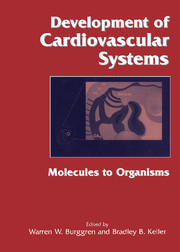Book contents
- Frontmatter
- Contents
- List of contributors
- Foreword by Constance Weinstein
- Introduction: Why study cardiovascular development?
- Part I Molecular, cellular, and integrative mechanisms determining cardiovascular development
- Part II Species diversity in cardiovascular development
- Part III Environment and disease in cardiovascular development
- 17 Oxygen, temperature, and pH influences on the development of nonmammalian embryos and larvae
- 18 Modeling gas exchange in embryos, larvae, and fetuses
- 19 Principles of abnormal cardiac development
- 20 In utero and postnatal interventions for congenital cardiovascular malformations
- 21 Applying the science of cardiovascular development to congenital cardiovascular malformations
- Epilogue: Future directions in developmental cardiovascular sciences
- References
- Systematic index
- Subject index
20 - In utero and postnatal interventions for congenital cardiovascular malformations
from Part III - Environment and disease in cardiovascular development
Published online by Cambridge University Press: 10 May 2010
- Frontmatter
- Contents
- List of contributors
- Foreword by Constance Weinstein
- Introduction: Why study cardiovascular development?
- Part I Molecular, cellular, and integrative mechanisms determining cardiovascular development
- Part II Species diversity in cardiovascular development
- Part III Environment and disease in cardiovascular development
- 17 Oxygen, temperature, and pH influences on the development of nonmammalian embryos and larvae
- 18 Modeling gas exchange in embryos, larvae, and fetuses
- 19 Principles of abnormal cardiac development
- 20 In utero and postnatal interventions for congenital cardiovascular malformations
- 21 Applying the science of cardiovascular development to congenital cardiovascular malformations
- Epilogue: Future directions in developmental cardiovascular sciences
- References
- Systematic index
- Subject index
Summary
Introduction
Advances in the management of congenital heart lesions have been dramatic in the brief 50-year history of congenital heart surgery (Figure 20.1; Schumacker, 1992). These advances were driven largely by the development of technology in the early years and by a sophisticated understanding of physiology and developmental biology more recently. In the early years of management of congenital heart lesions, mortality was the main determinant in choosing a particular surgical strategy. However, with time mortality has been markedly reduced. As a result, other criteria for determining the success of a particular surgical approach have been developed, for example, postoperative complications, convalescence, and hospital stay. With further refinements, long-term functional results have become the criteria for judging the success of a particular approach. At the present time optimal preservation of the structure and function of all organs is becoming the primary goal of management. Along with the development of appropriate surgical techniques for repair of congenital heart defects, the concept of appropriate timing of repair has come into clear focus over the past several decades. Intervention early in life appears to prevent or minimize secondary morphologic and functional consequences in all organs (Castaneda et al., 1993).
Extrapolating from the benefits achieved with “early” repair (neonatal and early infancy) of congenital heart lesions, and combining the information gained from this experience with observations made by developmental biologists and physiologists, it appears that certain congenital heart lesions can be most effectively repaired in utero.
- Type
- Chapter
- Information
- Development of Cardiovascular SystemsMolecules to Organisms, pp. 268 - 280Publisher: Cambridge University PressPrint publication year: 1998



